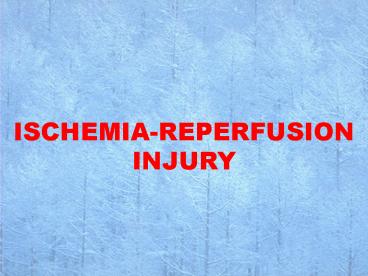ISCHEMIA-REPERFUSION INJURY - PowerPoint PPT Presentation
1 / 23
Title:
ISCHEMIA-REPERFUSION INJURY
Description:
ISCHEMIA-REPERFUSION INJURY What is ischemia-reperfusion injury? After prolonged ischemia, reestablishment of blood flow does not relieve ischemic injury,on the ... – PowerPoint PPT presentation
Number of Views:4511
Avg rating:3.0/5.0
Title: ISCHEMIA-REPERFUSION INJURY
1
ISCHEMIA-REPERFUSION INJURY
2
(No Transcript)
3
What is ischemia-reperfusion injury?
After prolonged ischemia, reestablishment of
blood flow does not relieve ischemic injury,on
the contrary aggravates the tissue injury
4
In the definition of ischemia-reperfusion
injury
- 3 Key points are
- After ischemia for a long time
- Reestablishment of blood flow
- More severe injury
5
Which factors are involved in reperfusion
injury
- Generally speaking,
- Duration of ischemia the longer period
of ischemia, the more severe injury - Severity of ischemia the more
grievous ischemia, the more severe injury - Speed of reperfusion the faster
reperfusion of blood, the more severe injury - Ischemia preconditioning increasing tolerance
to reperfusion injury
6
Why are more severe injury induced by
reestablishment of blood flow after ischemia?
- MICROVACULAR DAMAGENO-Reflow Phenomenon
- Vaso-endothelial edema
ATP depletion ?
decreased Na-K pump function ? Na and
water ? entering cell ? endorthelial edema - Vaso-endothelial damage
WBC
adherence ? OFR increase and NO decrease - Microvascular obstruction
Squeeze of the coronary arteries induced by
ischemic myocardium and by interstital
edema of myocardium
Adherence, Aggregation and Activation of WBC
7
2. The Role of Leukocyte
- Blocking microvasculature in the region
of reperfusion - Adhering to microvascular endothelium
through interaction between L-selectin on
surface of WBCand ICAM-1 on surface of
endothelium - Damaging tissues and cells in the region
of reperfusion through releasing arachidonic
acid (AA) ? TXA2, lysosomal enzymes etc. And
producing OFR in respiratory burst.
8
Damaged endothelium NO decrease CAMs
upregulation L-selectin ICAM-1 WBC ADHERENCE
to ENDOTHELIUM Releasing OFR, TXA2,
lysosomal enzymes Blocking blood
flow Damaging tissues and cell
9
- Calcium Overload
Intracellular calcium
concentration abnormally increases and leads to
cell and tissue damages
- How to maintain Intracellular calcium
- at normal level?
- Ca2 Pump on cell membrance
- Na - Ca2 exchage pump
- Ca2 Pump on mitochondrial membrane
- Ca2 Pump on endoplasmic reticulum
10
- Why dose calcium overload occur
- during reperfusion
- Depleted energe
- Increased permeability of cellular
- membrance
- Increased intracellular sodium
11
- What are effects of calcium overload
- Damage mitochondria ?
- ATP production decrease
- Cause myocardial injury ?
- contraction weakness
- promote OFR formation ?
- damege aggravation
12
- Role of
- Oxygen Free Radical
- OFR species
- O2. (superoxide anion radical)
- OH. (hydroxyl radical)
- 1O2 (single oxygen)
13
OFR sources mitochondria, catecholamine
autooxidation xanthine oxidase, activated wbc
and so on. OFR production In
ischemia-reperfusion injury a large amount
of OFR is produced.
ATP ?ADP ?AMP ?Adenosine ?Inosine ? Hypoxanthine
(ISCHEMIA) Xanthine dehydrogenase (XD)
Protease Ca 2
Xanthine oxidase (XO) (REPERFUSION) O.2
14
Destructive effects of OFR
- Attacking membrane structure such as
mitochondria membrane ? interfering with
energy metabolism - Attacking DNA ? changing genetic information
? cell death - Initiating lipid peroxidation ? increasing
permeability of membrane and inducing
destruction of membrane ? cell death - Destroying proteins ? decreased enzyme
activity ? metabolic disorder
15
Excess oxygen
Neutrophil Free radicals
infiltration ?
?
ISCHEMIAREPERFUSION INJURY
? ?
Microvascular damage Calcium overload
Major mechanisms of ischemia-
reperfusion injury
16
1.Vasomotor Responses OFR
Calcium Overload WBC ?
? ?
Damaged endothelium ?
? NO, PGI2 release?
TXA2,ET release? ?
? VASOCONSTRICTION
?
Aggravating injury
17
OFR Calcium Overload
WBC Damaged endothelium
Vascular Sticking
WBC Liable to form permeability?
platelets to endothelium thrombosis
Edema Releasing OFR
Blocking blood
proteolytic enzymes flow
Aggravating injury
18
Excess Oxygen Neutrophil
Microvascular Calcium Free radicals
infiltration damage
overload ? ?
? ?
ISCHEMIAREPERFUSION INJURY ?
? ? ?
Heart Brain Liver
Intestine ? ?
? ? Shock
Cytotoxic Jaundice Mucosal
Pump failure edema Enlargement
necrosis Arrhythmia Neuron death GTP?
Ulceration
Hemorrhage
19
????????
20
? ? ? ? ? ? ? ?
21
????/?????
22
(No Transcript)
23
How to prevent and treat
ISCHEMIAREPERFUSION INJURY ? Relieving
ischemic condition as a prerequisite Excess
Oxygen Calcium
Neutrophil Free radicals overload
infiltration ?
? ? ISCHEMIA-REPERFUS
ION INJURY ?
? ? OFR
Calcium WBC Scavenger
Antagonist Antiboby































